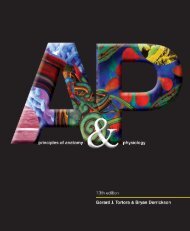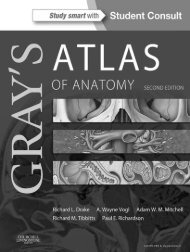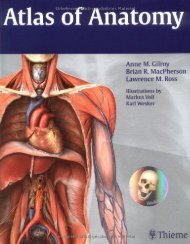urinalysis and body fluids
Create successful ePaper yourself
Turn your PDF publications into a flip-book with our unique Google optimized e-Paper software.
©2008 F. A. Davis<br />
CHAPTER 2 • Renal Function 13<br />
through the heart at all times. Blood enters the capillaries of<br />
the nephron through the afferent arteriole. It then flows<br />
through the glomerulus <strong>and</strong> into the efferent arteriole. The<br />
varying sizes of these arterioles help to create the hydrostatic<br />
pressure differential important for glomerular filtration <strong>and</strong> to<br />
maintain consistency of glomerular capillary pressure <strong>and</strong><br />
renal blood flow within the glomerulus. Notice the smaller<br />
size of the efferent arteriole in Figure 2-2. This increases the<br />
glomerular capillary pressure.<br />
Before returning to the renal vein, blood from the efferent<br />
arteriole enters the peritubular capillaries <strong>and</strong> the vasa<br />
recta <strong>and</strong> flows slowly through the cortex <strong>and</strong> medulla of<br />
the kidney close to the tubules. The peritubular capillaries<br />
surround the proximal <strong>and</strong> distal convoluted tubules, providing<br />
for the immediate reabsorption of essential substances<br />
from the fluid in the proximal convoluted tubule <strong>and</strong> final<br />
adjustment of the urinary composition in the distal convoluted<br />
tubule. The vasa recta are located adjacent to the<br />
ascending <strong>and</strong> descending loop of Henle in juxtamedullary<br />
nephrons. In this area, the major exchanges of water <strong>and</strong><br />
salts take place between the blood <strong>and</strong> the medullary interstitium.<br />
This exchange maintains the osmotic gradient (salt<br />
concentration) in the medulla, which is necessary for renal<br />
concentration.<br />
Based on an average <strong>body</strong> size of 1.73 m 2 of surface, the<br />
total renal blood flow is approximately 1200 mL/min, <strong>and</strong> the<br />
total renal plasma flow ranges 600 to 700 mL/min. Normal<br />
values for renal blood flow <strong>and</strong> renal function tests depend on<br />
<strong>body</strong> size. When dealing with sizes that vary greatly from the<br />
average 1.73 m 2 of <strong>body</strong> surface, a correction must be calculated<br />
to determine whether the observed measurements represent<br />
normal function. This calculation is covered in the<br />
discussion on tests for glomerular filtration rate (GFR) later<br />
in this chapter. Variations in normal values have been published<br />
for different age groups <strong>and</strong> should be considered<br />
when evaluating renal function studies.<br />
Glomerular Filtration<br />
The glomerulus consists of a coil of approximately eight capillary<br />
lobes referred to collectively as the capillary tuft. It is<br />
located within Bowman’s capsule, which forms the beginning<br />
of the renal tubule. Although the glomerulus serves as a nonselective<br />
filter of plasma substances with molecular weights of<br />
less than 70,000, several factors influence the actual filtration<br />
process. These include the cellular structure of the capillary<br />
walls <strong>and</strong> Bowman’s capsule, hydrostatic <strong>and</strong> oncotic pressures,<br />
<strong>and</strong> the feedback mechanisms of the reninangiotensin-aldosterone<br />
system. Figure 2-3 provides a<br />
diagrammatic view of the glomerular areas influenced by<br />
these factors.<br />
Cellular Structure of the Glomerulus<br />
Plasma filtrate must pass through three cellular layers: the<br />
capillary wall membrane, the basement membrane (basal<br />
lamina), <strong>and</strong> the visceral epithelium of Bowman’s capsule.<br />
The endothelial cells of the capillary wall differ from those in<br />
other capillaries by containing pores <strong>and</strong> are referred to as<br />
fenestrated. The pores increase capillary permeability but do<br />
not allow the passage of large molecules <strong>and</strong> blood cells. Further<br />
restriction of large molecules occurs as the filtrate passes<br />
through the basement membrane <strong>and</strong> the thin membranes<br />
covering the filtration slits formed by the intertwining foot<br />
processes of the podocytes of the inner layer of Bowman’s capsule<br />
(see Fig. 2-3).<br />
Afferent<br />
arteriole<br />
Efferent<br />
arteriole<br />
Bowman’s<br />
capsule<br />
Glomerulus<br />
Juxtaglomerular<br />
apparatus<br />
Proximal<br />
convoluted<br />
tubule<br />
Peritubular<br />
capillaries<br />
Thick descending<br />
loop of Henle<br />
Vasa recta<br />
Thin descending<br />
loop of Henle<br />
Distal<br />
convoluted<br />
tubule<br />
Collecting<br />
duct<br />
Vasa recta<br />
Thick ascending<br />
loop of Henle<br />
Thin ascending<br />
loop of Henle<br />
Cortex<br />
Medulla<br />
Figure 2–2 The nephron <strong>and</strong> its component parts.

















